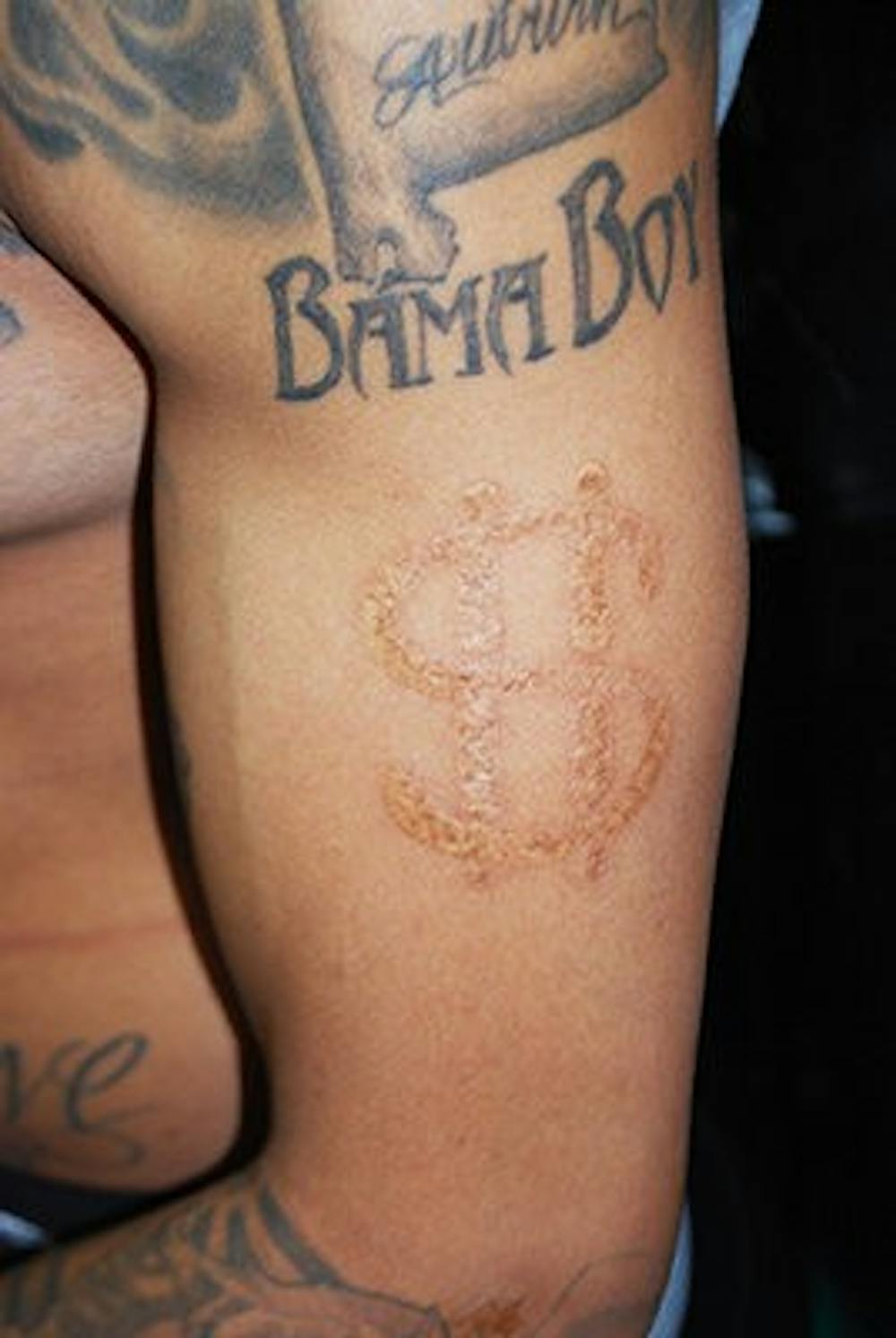The 13-year-old flicked on his grandmother's gas stove. He held a piece of a straightened wire clothes hanger over the flame. He waited with an ice pack on his bicep until the piece of metal glowed red.
Then, he touched the hot wire to his skin, branding his arm with his initials, a peace sign and a heart.
"I thought it was awesome," said Mark Horton, tattoo artist at Shenanigan's. "And you know, when you're in junior high school on the way to high school--all that peer pressure--trend-setters are, like, the 'shiznit.'"
Horton said he was involved in an after-school outreach project with Auburn University's chapter of Alpha Phi Alpha when he saw fraternity letters branded on a brother's arm and decided to try branding himself.
"It could've been bad," Horton said laughing. "Yeah, that's one of the stupidest things I ever did."
Fraternity branding is a trend received with mixed emotions.
For brothers who participate in branding, it is an honor to have the Greek letters permanently emblazoned on their bodies, but the decision is left up to fraternity members whether they receive a brand or not.
"As a kid, growing up, my father always had them on his body and I'd touch them and I always wanted to get one myself," said Cameron Gray, 2013 Auburn graduate and Omega Psi Phi brother. "After I joined the same fraternity he was in, I was granted the opportunity to get one. I did it. There was no question about what I wanted and where I wanted to get it."
Gray sports three brands, all representing his fraternity.
Branding is a choice for any brother after initiation and shouldn't be considered hazing, according to Gray. He explained he was one of few fraternity brothers to receive the brand.
"I'm very proud of my letters and have a lifelong bond with my brothers and my fraternity," Gray said. "It's like a coat of arms that I can forever wear on my body."
Gray compared scarification, the technical term for branding, to self-inflicted wounds performed by African tribes.
"It's almost like a shift back to Africa where people would scar themselves to show their manhood and, in that kind of sense, it's kind of in the same realm," said Gray. "Branding and tattoos and all of that stuff is just like expressing yourself through body art and body modification."
Devante Brown, junior in mechanical engineering, president of Auburn's National Pan-Hellenic Council and member of Auburn's chapter of Omega Psi Phi, said branding isn't directly connected to fraternity functions nor is it a practice that prevents a fraternity brother from moving up in rank.
"I actually don't have brands myself, and I'm still an Omega," Brown said. "It's just a way of expressing yourself. It's the same exact principle as getting a tattoo."
Branding has been common among fraternities for decades, but the growth of fraternities like Omega Psi Phi has brought the practice of branding into the public eye, according to Brown.
Jeremy Wiley, senior in chemical engineering and president of the Omicron Kappa Chapter of Alpha Phi Alpha Fraternity, said branding has become rarer in his fraternity since Horton's experience in the early '90s.
"It's up to the member's discretion to do it, but we don't really do branding at all," Wiley said. "It's not recommended, nor is it discouraged. If you want to get one, you can get one, but it's not forced upon you."
Wiley said branding was popular among Omega Psi Phi brothers.
"A lot of their members usually get brands," said Wiley. "But for my fraternity, it's not common at all."
Branding among fraternities is not limited to Auburn University.
Curtis Harris, 2005 graduate of Stillman College in Tuscaloosa also received a brand on each arm from his Phi Beta Sigma brothers.
"Don't ever let anybody tell you it's required," Harris said. "You don't have to get it."
Harris said a fraternity brand unites the initiated members and is representative of what they've experienced as a group.
"It means something to you," Harris said. "It's a special moment and a special time in your life. You really earned it. You don't have to get it, but they look at is as a symbol of loyalty, [like,] 'He's in it for life, and he'll represent our fraternity with honor for life.'"
Other fraternities on Auburn's campus discourage branding.
"A brand just seems crude and not tasteful to me," said Collin Carnahan, fifth-year senior in professional flight management and a member of Delta Tau Delta. "I'd don't think I'd let a pledge get a brand or a tattoo because, as a freshman, I didn't know what fraternity I wanted to commit to or drop. Even now, I wouldn't get one."
Voodoo Neetle is one of a few Auburn tattoo shops that brands professionally.
"It's like a controlled third degree burn," said tattoo artist and branding specialist, Henry Key. "It's pretty gnarly when it comes out."
Key said he uses a cauterizing tool to seal the skin and create a scarring effect.
"I've done a couple fraternity brands," Key said. "It's still the same, but they usually do it in chapter, and they do strike branding instead of cauterizing."
A shaped coat hanger heated over a stove or an open flame only reaches 700-800 degrees, which causes large keloid scaring, Key explained.
"It's not hot enough to cook the skin thoroughly," Key said. "That's when you get the big, bubbled up brands."
During professional scarification, there is little risk for infection, according to Key.
"It burns and kills the bacteria when it touches. It completely seals the wound immediately," said Key. "No more danger than just extreme pain."
Do you like this story? The Plainsman doesn't accept money from tuition or student fees, and we don't charge a subscription fee. But you can donate to support The Plainsman.





